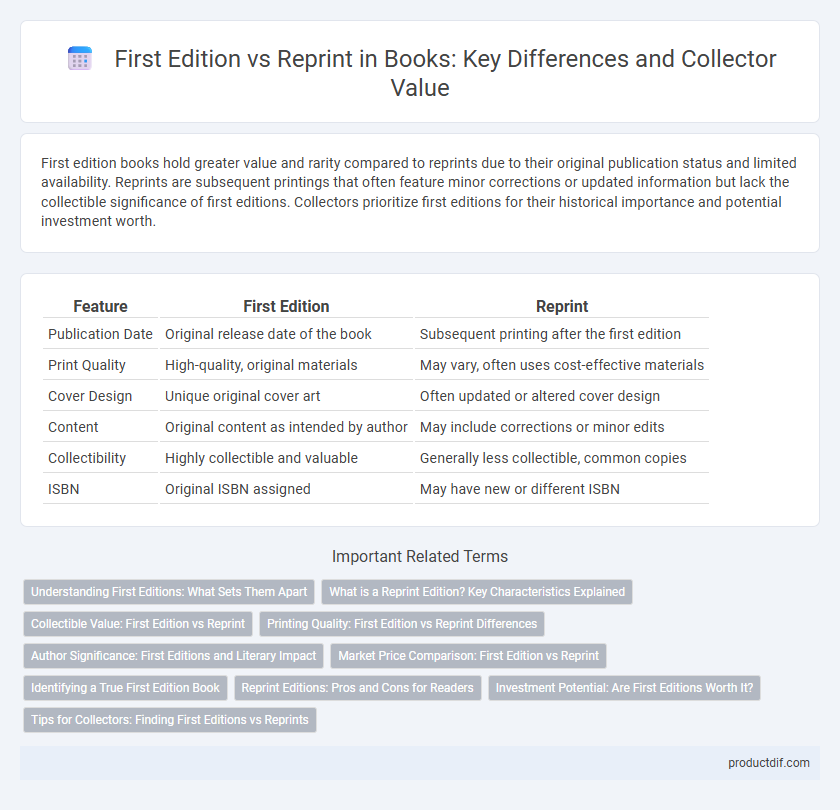First edition books hold greater value and rarity compared to reprints due to their original publication status and limited availability. Reprints are subsequent printings that often feature minor corrections or updated information but lack the collectible significance of first editions. Collectors prioritize first editions for their historical importance and potential investment worth.
Table of Comparison
| Feature | First Edition | Reprint |
|---|---|---|
| Publication Date | Original release date of the book | Subsequent printing after the first edition |
| Print Quality | High-quality, original materials | May vary, often uses cost-effective materials |
| Cover Design | Unique original cover art | Often updated or altered cover design |
| Content | Original content as intended by author | May include corrections or minor edits |
| Collectibility | Highly collectible and valuable | Generally less collectible, common copies |
| ISBN | Original ISBN assigned | May have new or different ISBN |
Understanding First Editions: What Sets Them Apart
First editions of books are highly valued for being the original print run, often containing unique typographical features, author signatures, or limited printing errors that distinguish them from later reprints. These editions represent the first time the text was made available to the public, capturing the original publication's cultural and historical context. Collectors and bibliophiles prioritize first editions due to their rarity, authenticity, and potential long-term value in the rare book market.
What is a Reprint Edition? Key Characteristics Explained
A reprint edition is a subsequent printing of a book that reproduces the original content without significant changes in text or design, often issued to meet ongoing demand after the first edition sells out. Key characteristics include identical pagination, unchanged content, and sometimes a note indicating it is a reprint or later printing. Unlike first editions, reprints usually lack the collectible value associated with the book's initial release and serve primarily to make the work more widely available.
Collectible Value: First Edition vs Reprint
First editions hold significantly higher collectible value compared to reprints due to their original printing status and often limited availability. Collectors prioritize first editions for their rarity, unique markings, and historical significance within the book market. Reprints, while more accessible and affordable, generally lack the investment potential and prestige associated with first edition copies.
Printing Quality: First Edition vs Reprint Differences
First edition books typically feature higher printing quality with sharper text and more vibrant illustrations due to limited print runs and meticulous quality control. Reprints often use cheaper materials and faster printing processes, resulting in less precise color accuracy and occasional misaligned text. Collectors value first editions for their superior craftsmanship and authentic representation of the original publication.
Author Significance: First Editions and Literary Impact
First editions hold unique significance as they represent the author's original vision and creative expression at the moment of initial publication. Collectors and literary scholars value these editions for their authenticity and potential textual variations that may differ from reprints. The impact of first editions extends beyond rarity, often influencing the historical and cultural reception of a work within the literary canon.
Market Price Comparison: First Edition vs Reprint
First edition books generally command higher market prices due to their rarity and collector demand, often appreciating over time, especially if in pristine condition. Reprints, while more accessible, hold significantly lower value and rarely experience substantial price increases. Key factors influencing this price disparity include print run size, historical significance, and the book's cultural impact.
Identifying a True First Edition Book
A true first edition of a book is identified by the original print run that includes unique markers such as the publisher's specific first edition statement, the absence of later printings or reprint numbers, and original dust jacket details. Key indicators often include the printing number line, exclusive copyright date, and distinctive typographical errors corrected in later editions. Collectors prioritize these features to verify authenticity and value, distinguishing the true first edition from subsequent reprints or later state editions.
Reprint Editions: Pros and Cons for Readers
Reprint editions offer readers affordable access to popular books without compromising the core content, making them ideal for casual readers and students. However, reprints may feature changes in formatting, updated cover art, or revised text, which can differ from the original first edition's authenticity and collectibility. Collectors often prioritize first editions for their rarity and potential value appreciation, while reprints provide practical benefits like improved print quality and availability.
Investment Potential: Are First Editions Worth It?
First editions often hold higher investment potential due to their rarity, original print quality, and historical significance, making them sought after by collectors and investors. Reprints typically lack the unique value and authenticity of first editions, resulting in lower market demand and resale prices. Understanding the edition's impact on book valuation is crucial for buyers aiming to maximize returns in the rare book market.
Tips for Collectors: Finding First Editions vs Reprints
Collectors should scrutinize the copyright page for publication dates and edition statements, as first editions often have unique identifiers or absence of later print run markings. Examining physical characteristics such as dust jackets, binding quality, and typographical errors can distinguish first editions from reprints, since first editions frequently showcase original design elements or printing anomalies. Engaging with specialized bibliographies and consulting rare book dealers enhances accuracy in identifying authentic first editions and assessing their market value.
First Edition vs Reprint Infographic

 productdif.com
productdif.com